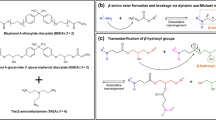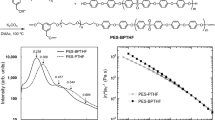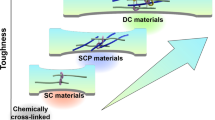Abstract
Unimodal and bimodal networks of physically crosslinked polyborodimethylsiloxane (PBDMS) were prepared by end-linking hydroxy-terminated polydimethylsiloxane (PDMS) with boric acid. Their viscoelastic and equibiaxial extension behaviors were investigated. Three PDMS precursors with different number-average molecular weight (\( {\overline{M}}_n \)) were employed, of which the shortest chain had \( {\overline{M}}_n \) lower than the entanglement molecular weight. Bimodal networks were prepared from the mixture of the shortest and the longer PDMS chains. Linear viscoelastic behavior of unimodal network of the shortest chain gave the best fit to the Maxwell model with single relaxation time of 1.59 s, and equilibrium elastic modulus (G e ) of the network was well-explained by phantom network model. The unimodal networks from the other two long chain precursors, however, showed multi-relaxation behavior with the longest relaxation times of 1.00–1.26 s. Moreover, their G e was close to affine model and deviated from the phantom model with trapped entanglement factors of ~ 0.13. The bimodal networks with high mole percentage of short chains gave G e values approximate to the predicted values of phantom model. Such bimodal networks showed an extremely large increase in modulus at high biaxial extension, attributed by the limited extensibilities of short chains and un-relaxed crosslinked junctions.




Similar content being viewed by others
References
Mark JE (1982) The use of model polymer networks to elucidate molecular aspects of rubberlike elasticity. Adv Polym Sci 44:1–26
Mark JE (2003) Some recent theory, experiments, and simulations on rubberlike elasticity. J Phys Chem B 107:903–913
Queslel JP, Mark JE (1984) Molecular interpretation of the moduli of elastomeric polymer networks of known structure. Adv Polym Sci 65:137–176
Urayama K, Kawamura T, Kohjiya S (2009) Structure-mechanical property correlations of model siloxane elastomers with controlled network topology. Polymer 50:347–356
Wang S, Mark JE (1992) Unimodal and bimodal networks of poly(dimethyl-siloxane) in pure shear. J Polymer Sci, Part B: Polymer Phys 30:801–807
Genesky GD, Cohen C (2010) Toughness and fracture energy of PDMS bimodal and trimodal networks with widely separated precursor molar masses. Polymer 51:4152–4159
Sharf MA, Mark JE, Alshamsi AS (1996) Moduli of elastomeric networks prepared by tetrafunctionally endlinking vinyl-terminated poly(dimethylsiloxane) chains at low temperature. Polym J 28:375–382
Goertz MP, Zhu XY, Houston JE (2009) Temperature dependent relaxation of a “solid-liquid”. J Polymer Sci, Part B: Polymer Phys 47:1285–1290
Hou A, Si C, Zhou Y (2009) Self-assembly of the polysiloxane modified with cationic and perfluorocarbon groups on the polyester surface and its effect on the color shade of the dyed polyester. J Polym Res 16:687–692
Wang Y, Du L, Zhang J, Feng S (2011) A thermosensitive supramolecular aggregation from linear telechelic polydimethylsiloxane with self-assembly units. J Polym Res 18:1635–1643
Langley NR (1968) Elastically effective strand density in polymer networks. Macromolecules 1:348–352
Chatraei SH, Macosko CW, Winter HH (1981) Lubricated squeezing flow: a new biaxial extensional rheometer. J Rheol 25:433–443
Soskey PR, Winter HH (1985) Equibiaxial extension of two polymer melts: polystyrene and low density polyethylene. J Rheol 29:493–517
Takahashi M, Isaki T, Takigawa T, Masuda T (1993) Measurement of biaxial and uniaxial extensional flow behavior of polymer melts at constant strain rates. J Rheol 37:827–846
Song Y, Zheng Q (2008) Network formation in glycerol plasticized wheat gluten as viewed by extensional deformation and stress relaxation: final conclusions. Food Hydrocolloids 22:647–681
Fried JR (1995) Polymer science and technology. Prentice-Hall International, Inc, New Jersey
Gottlieb M, Macosko CW, Benjamin GS, Meyers KO, Merrill EW (1981) Equilibrium modulus of model poly(dimethylsiloxane) networks. Macromolecules 14:1039–1046
Urayama K, Yokoyama K, Kohjiya S (2001) Viscoelastic relaxation of guest linear poly(dimethylsiloxane) in end-linked poly(dimethylsiloxane) networks. Macromolecules 34:4513–4518
Kavanagh GM, Ross-Murphy SB (1998) Rheological characterisation of polymer gels. Prog Polym Sci 23:533–562
Pellens L, Ahn KH, Lee SJ, Mewis J (2004) Evaluation of a transient network model for telechelic associative polymers. J Non-Newtonian Fluid Mech 121:87–100
Patel SK, Malone S, Cohen C, Gillmor JR, Colby RH (1992) Elastic modulus and equilibrium swelling of poly(dimethylsiloxane) networks. Macromolecules 25:5241–5251
Doi M, Edwards SF (1986) The theory of polymer dynamics. Clarendon, Oxford
Liu C, He J, Ruymbeke E, Keunings R, Bailly C (2006) Evaluation of different methods for the determination of the plateau modulus and the entanglement molecular weight. Polymer 47:4461–4479
Takahashi H, Shibyama M, Fujisawa H, Noruma S (1995) Equilibrium swelling and small-angle neutron-scattering study on end-linked poly(tetrahydrofuran) networks. Macromolecules 28:8824–8828
Treloar LRG (2005) The physics of rubber elasticity, 3rd edn. Oxford University Press, United Kingdom
Rietjens M, Steenbergen PA (2005) Crosslinking mechanism of boric acid with diols revisited. Eur J Inorg Chem 2005:1162–1174
Sottos N, White S, Bond I (2007) Introduction: self-healing polymers and composites. J R Soc Interface 4:347–348
Cotton FA, Wilkinson G (1980) Advanced inorganic chemistry, 4th edn. Wiley, New York
Klüppel M (1992) Trapped entanglements in polymer networks and their influence on the stress-strain behaviour up to large extensions. Prog Collied Polym Sci 90:137–143
Flory PJ (1977) Theory of elasticity of polymer networks. The effect of local constraints on junctions. J Chem Phys 66:5720–5729
Dossin LM, Graessley WW (1979) Rubber elasticity of well-characterized polybutadiene networks. Macromolecules 12:123–130
Langley NR, Ferry JD (1968) Dynamic mechanical properties of cross-linked rubbers. VI. Poly(dimethylsiloxane) networks. Macromolecules 1:353–358
Tanaka F, Edward SF (1992) Viscoelastic properties of physically cross-linked networks. Transient network theory. Macromolecules 25:1516–1523
Genesky GD, Aguilera-Mercado BM, Bhawe DM, Escobedo FA, Cohen C (2008) Experiments and simulations: enhanced mechanical properties of end-linked bimodal elastomers. Macromolecules 41:8231–8241
Llorente MA, Andrady AL, Mark JE (1981) Model networks of end-linked polydimethylsiloxane chains. XI. Use of very short network chains to improve ultimate properties. J Polymer Sci, Part B: Polymer Phys 19:621–630
Mark J, Erman B (1988) Rubberlike elasticity: A molecular primer. Wiley-Interscience, New York
Andrady AL, Llorente MA, Mark JE (1980) Model networks of end-linked polydimethylsiloxane chains. VII. Networks designed to demonstrate non-Gaussian effects related to limited chain extensibility. J Chem Phys 72:2282–2290
Sakrak G, Bahar I, Erman B (1994) Computer simulations of two-dimensional trifunctional bimodal networks. Macromol Theory Simul 3:151–161
Acknowledgments
The authors would like to acknowledge the financial support from the National Metal and Materials Technology Center, National Science and Technology Development Agency (NSTDA), Thailand (Project No. MT-B-53-POL-07-485-I).
Author information
Authors and Affiliations
Corresponding author
Rights and permissions
About this article
Cite this article
Seetapan, N., Fuongfuchat, A., Sirikittikul, D. et al. Unimodal and bimodal networks of physically crosslinked polyborodimethylsiloxane: viscoelastic and equibiaxial extension behaviors. J Polym Res 20, 183 (2013). https://doi.org/10.1007/s10965-013-0183-8
Received:
Accepted:
Published:
DOI: https://doi.org/10.1007/s10965-013-0183-8




